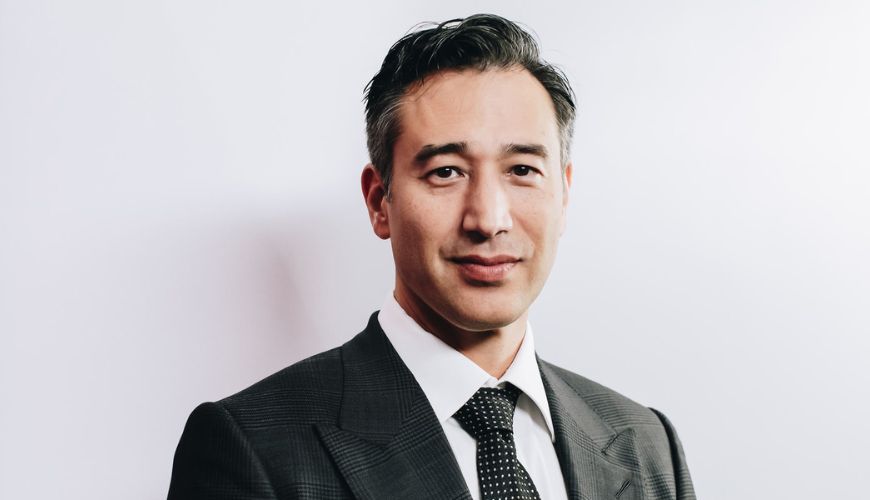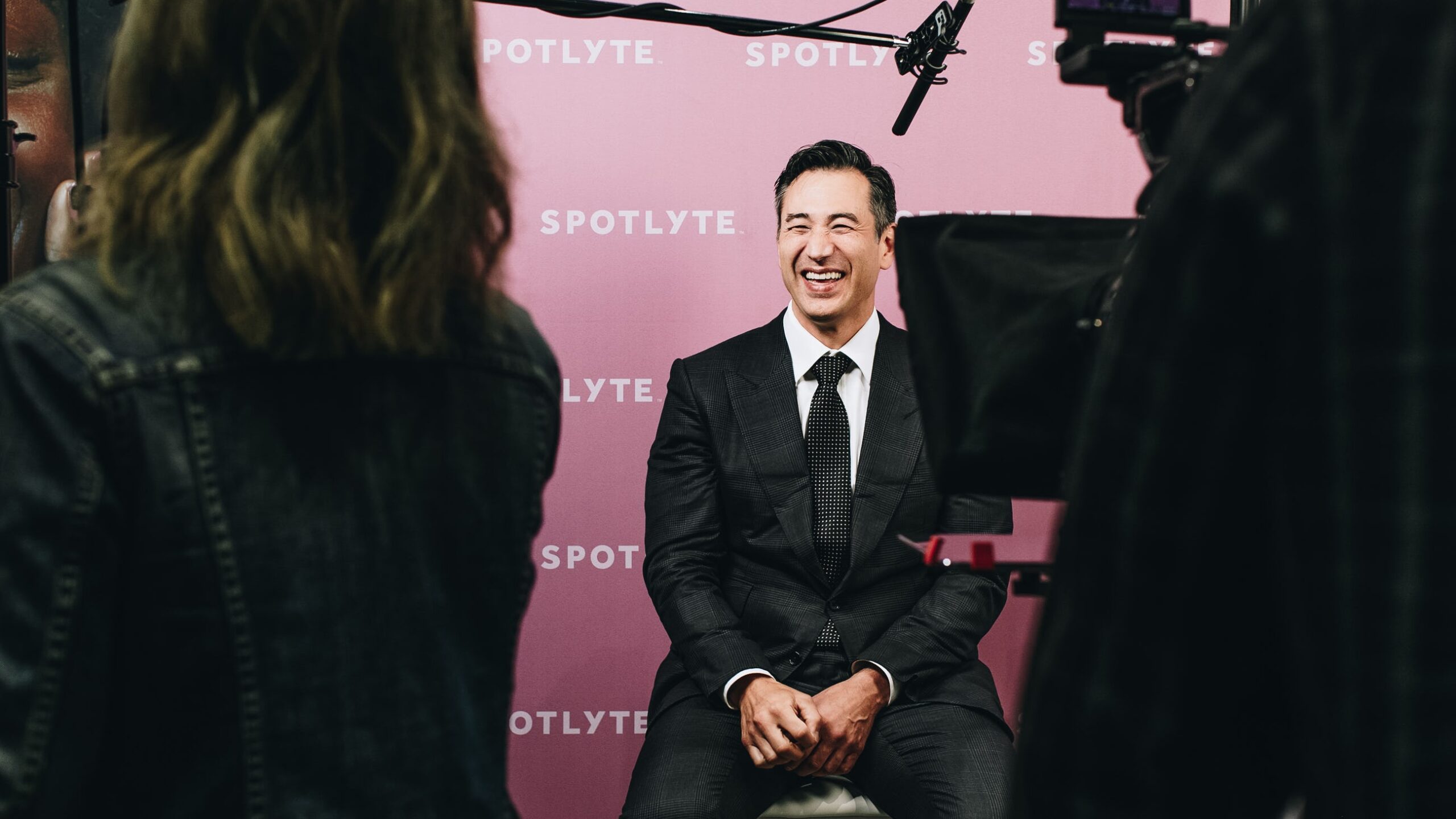Dr. Leif Rogers Has Predictions On The Future Of Plastic Surgery — And They Might Surprise You
Thespotlyte | July 27, 23

It’s 12:59 p.m. in San Diego, and I’m standing in a space the size of an aircraft hangar. Surrounding me are some of the nation’s — nay, world’s — top plastic surgeons, bumping around like free flowing gas molecules. I’m in the American Society of Plastic Surgeons® (ASPS) exhibition hall, where I’ve scheduled an interview with Leif Rogers, MD at 1 p.m. — but among the stimulus of gadgetry (Robotic endoscopes! Statuesque surgical tools!) and swaths of men in navy blue suits (women seem grossly underrepresented, and navy blue is markedly popular), I’m beginning to wonder whether I’ll spot my subject.
1 p.m. strikes, and to my relief, Dr. Rogers is walking swiftly toward our meeting spot. I needn’t have worried about spotting him; even in a throng, he has an unmistakable presence.
“Dr. Rogers?” a fellow surgeon tries, stopping Rogers in his tracks. “I’ve seen your work on Instagram®!”
For most people, “IRL” (in real life) recognition of this sort is enough self-validation to prove Instagram success. But, as a doctor who started his practice before selfies even existed, Dr. Rogers admits that social media savvy is a skill he continues to develop (albeit rapidly, judging by his almost 40K followers).
“Some people really have [Instagram] strategies figured out, and other people are just learning,” he says. “I’m somewhere in the middle.” Below, the 49-year-old shares more about how social media is changing the aesthetics industry — plus, his unconventional pastime, and the surprising predictions he has for the future of plastic surgery.
Spotlyte: Did you always know you wanted to be a plastic surgeon?
Dr. Leif Rogers: Not always. When I was in high school, I knew I wanted to do something creative. I thought I would do either architecture or potentially surgery of some kind. My parents were always pushing me towards surgery.
In college, I took an architecture 101 class. They turned out the lights and put up slides of columns . . . and I was like, “I’m so out of here!” So I thought, all right, it’s got to be medicine then.
Spotlyte: How did you decide to pursue plastic surgery specifically?
LR: [Initially], I was leaning towards orthopedics. Because as a kid you think, “Oh, plastic surgery, it’s just surgery for vain people, right?” How am I really changing the world? So when I started medical school, I was focusing more on orthopedics. The more I learned, though, the more I realized I would be bored. It’s great surgery, and it’s technically fulfilling to some degree — but it just wasn’t enough variation or variety for me.
[But] with plastics, you can work from head to toe. And every patient is a new puzzle; every situation is a little bit different.
Spotlyte: You’ve also lended your skills to charitable work — could you tell us a little bit about that?
LR: I go to Guatemala almost every year — I’ve missed one year in the last nine, I think. I [travel with] a nice multidisciplinary group of about a hundred [doctors], including ENT, GYN, general surgery, internal medicine, pediatricians, and dentists. We mostly [operate on] clefts, but we also [treat] burns and essentially whatever comes. [I do] anywhere from 20 to 30 cases in four days [during these trips].
Spotlyte: That must be back to back to back!
LR: Yeah. We sleep a little bit, but it’s fulfilling.
Spotlyte: Speaking of sleep — do you get much?
LR: For years, I lived on four or five hours a night. Now I get real sleep, thankfully. I don’t know if I could go back to [less sleep]. I’m too old.
Spotlyte: Plus, you have a wife, two daughters, and a son now. How do you maintain work-life balance?
LR: I try to finish my day at a reasonable time, which doesn’t always happen. If I have a clinic day, I’ll see [my kids] in the morning before they go to school, but otherwise I see them at night and on the weekends. My wife helped me build my practice from the beginning. But now, because we have kids, she’s more part-time.
Spotlyte: What are you up to in your free time?
LR: One of my current hobbies, and has been for the last year and a half, is building a kit car in my garage.
Spotlyte: A — what?
LR: Most people have no idea what that is. A kit car is a car that comes essentially in boxes, and you put it together. There are different variations. But this particular one literally comes as a frame, and like 50 boxes of parts. So you have to put it together, and it becomes a car you can actually drive. You have to be somewhat mechanically inclined.
Spotlyte: In addition to the range of surgical procedures you perform, do you offer any injectable treatments?
LR: Yes. I [perform] some injectables. As far as fillers go, not everyone [injector] is equal. People say, “Oh, but I can get [filler] across the street for half the price.” But it’s not [just] about how much you’re paying for the product. It’s who’s putting it in your face. You can have a house painter or you can have Rembrandt. They’re both painters, right?
EDITOR’S NOTE: Injectable wrinkle reducers temporarily smooth the look of moderate to severe wrinkles in certain areas of the face, including the forehead, frown lines, and crow’s feet; they should not be used more frequently than every three months. Injectable filler is a temporary treatment that adds volume to areas of the face such as the lips, cheeks, and laugh lines. Like any medical treatment, both injectable wrinkle reducers and injectable fillers have potential risks and side effects. Talk to a licensed provider to see if they’re right for you.
Spotlyte: Would you consider yourself an artistic person in other ways?
LR: Yes, actually. As a kid, I was always the artist of my class — I was constantly drawing or sculpting. This lasted until high school, when I started noticing girls and sports . . . so my focus shifted a little bit. But [one of] the reasons I like plastic surgery is because of its artistic aspects.

Spotlyte: You’re active on Instagram. Do you think social media is affecting the aesthetics industry?
LR: I think social media is taking over the marketing in plastic surgery. When I started, marketing of any kind wasn’t even really allowed.
Spotlyte: How so?
LR: The [various medical] societies would penalize you, or threaten to kick you out if you marketed in any way other than listing your name in the yellow pages. Several years out of my training, they decided that it was okay to use advertisements. So they started with magazines, and some people start doing commercials. And then social media came around, and I was a little late to that game because it’s new to me. I’m not of that generation.
Spotlyte: Have you noticed the generational gap manifests itself in any way?
LR: These young guys come out [of medical school], and they’re so busy [working] in like two years. I’m like, “How’d you do that?” And they’re like, “Oh, I had social media.” If you don’t use it these days, you get left behind.
Spotlyte: What kinds of content seems to do well?
LR: We post what we’re doing during the day, partially because patients seem to like it. We post a little bit of my personal life, because patients seem to like it. But I think what matters the most is before and afters, and surgical things.
Spotlyte: What about skincare? Do you have a routine?
LR: No, I’m the worst. I use soap. Surgeons in general are not fussy, because our training was so difficult. We didn’t have time for routine. We barely slept. You get up, you hopefully rinse off, and go to work. So I think a lot of us just carry that over into the rest of our lives.
Spotlyte: Do you think you’ll ever start using skincare?
LR: Maybe. I’m getting to that age where I’m starting to notice significant age-related changes. And some of the creams now, they actually do something. Whereas back in the day, they were all the same: They hydrated your skin to some degree, and half of them gave you acne. But now, they’re adding peptides and growth factors; ingredients that can really can make a difference [in your skin].
Spotlyte: How do you feel about lasers and other non-invasive treatments?
LR: Radiofrequency is one of the best energies out there, and there are so many devices now. The ones we have [at our practice] are really effective, but there’s always new stuff coming out. There’s a real danger [of getting left behind] these days when it comes to the non-invasive treatments. Non-invasive [treatments] are slowly displacing surgery.
Spotlyte: How so?
LR: Things like Coolsculpting®, for instance. It’s been out for a while. It works. For those patients who are on the fence [about surgical fat removal;, and would rather not have surgery, they’re [usually] going to [inquire about] Coolsculpting. So you [may have] just lost a surgical patient. But that doesn’t mean that it’s going to ruin your practice. [Plastic surgeons] worry, “Oh my God, my patients are all going to do [non-invasive treatments] instead of surgery.” But that’s not true — it just changes the way the patients come to you.
EDITOR’S NOTE: The CoolSculpting treatment is a non-invasive fat freezing treatment that effectively reduces fat in certain self-proclaimed “problem spots” in the submental and submandibular areas, thigh, abdomen, flank, and upper arm, along with bra fat, back fat, and underneath the buttocks (you know, those bulges that just won’t go away, regardless of how much you sweat it out on the treadmill). While it isn’t a weight loss solution, fat-freezing can reduce pouches of fat. As with any procedure, there are risks and side effects, so talk to a licensed provider to see if it’s right for you.
Spotlyte: Can you give an example?
LR: A friend of mine who is maybe 15 years my senior [performs all types of surgery], but mostly facelifts. Back when Ultherapy® was first coming out, I was a spokesperson for them in a small way because I was an early adopter. And my friend kept asking me about it, and he wouldn’t buy it because he was afraid it would cannibalize his facelift patients. I kept trying to tell him that’s not the way it works.
Spotlyte: How does it work?
LR: You’re going to get patients who don’t need facelifts. But instead of you telling them, go away, come back to me in 10 years, now you keep them. Eventually they’re still going to need the facelift. It might take a little longer, but they’re not going away.
Spotlyte: Do you think plastic surgery and minimally invasive treatments are mutually exclusive?
LR: Surgery [treats] certain things, but not everything. We do still use filler [sometimes] on patients after surgery.
Spotlyte: Any predictions on the future of the aesthetics industry?
LR: I predict that non-invasive technologies and devices are going to eventually take over. I do think that the surgical arts are going to diminish. And we’re going to get there relatively soon. I think in our lifetime. In your lifetime at least.






